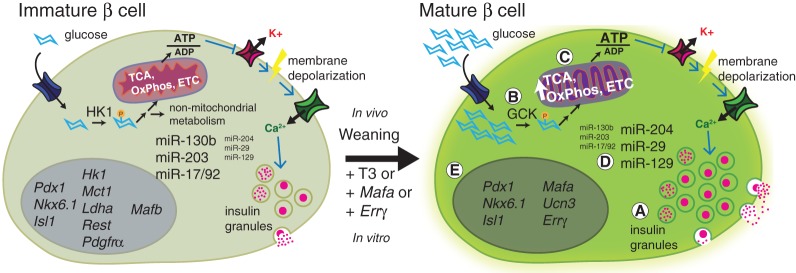Figure 1.
Molecular and metabolic changes associated with functional maturation of rodent β cells. Both immature and mature β cells are lineage-specified but differ in their insulin secretion response to glucose. (A) Mature β cells contain more insulin granules and secrete more insulin when stimulated with high levels of glucose. (B) One of the major differences between immature and mature β cells is the switch in expression from high-affinity hexokinase (HK) to low-affinity glucokinase (GCK). Glucose metabolism is thus only activated in mature cells in the presence of elevated levels of glucose. (C) Glucose-responsive respiration is also enhanced through the up-regulation of metabolic components involved in the tricarboxylic acid (TCA) cycle, oxidative phosphorylation (OxPhos), and electron transport chain (ETC). (D) Changes in the expression pattern of microRNAs (miRs) during β-cell maturation directly regulate metabolic gene targets as well as disallowed genes (Box 1). (E) In addition to expressing canonical β-cell transcription factors that are present in immature cells (Pdx1, Nkx6.1, and Isl1), mature β cells express additional maturation genes such as MafA, urocortin3 (Ucn3), and estrogen-related receptor γ (Errγ). β-Cell-disallowed genes Hk1, monocarboxylate carrier 1 (Mct1), lactate dehydrogenase A (Ldha), repressor element 1 silencing transcription factor (Rest), and platelet-derived growth factor receptor α (Pdgfrα) are also down-regulated during maturation.

